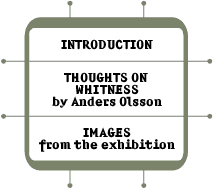
"A Century of Innocence - the history of the white monochrome" is the Rooseum's project for Kulturbro 2000. The title indicates our ambition: to provide an overview of the development of art in the twentieth century; but not viewed from a traditional arthistory perspective, with the stylistic schools of art history constantly succeeding one another. Instead the intention of the exhibition is to illuminate the history of art from a specific perspective - that of the white monochrome. Despite the restricted point of departure, "A Century of Innocence" is a manyfaceted, "different" picture of the century, from early modernism to the present day.
Our modern idea of the colour white has its roots in the nineteenth-century literary milieu where the white colour was associated with death and thus with evil forces. It was Kandinsky - the foremost colour theoretician of modernism - who recharged the colour white for the twentieth century, turning its negative power into something neutral that belongs with emptiness. But in contrast to the view of nineteenthcentury man, this emptiness involved not a threat but a possibility. In his book Concerning the Spiritual in Art, Kandinsky wrote of the white colour as something primal and full of innocence, as the colour of Creation.
However, the neutrality of whiteness was to be rejected by Kazimir Malevich, who in 1918 painted White on White - one of the most significant icons of the twentieth century. Malevich radicalized the whole idea of the white colour as something separate. He combined the white colour with an abstract formal idiom and thus a coordinated aesthetic unity arose. Thus Malevich stressed the fundamental opposition of modernism between spirit and matter, which has only reached total resolution in our own time. Malevich set up a contrast between the purity of art, as art that is "about art", and the function of art in the service of society. In so doing he set the agenda for the two most important issues of modernism.
During the fifties and sixties a number of artists tried to resolve the duality of the spiritual and the material in order to create a new totality. In the sixties another type of totality also grew up in the form of consciousness of context. The white monochrome as a physical object was to be replaced by an expanded sense of space where the work of art was a perfectly natural part of the archi-tecture of the gallery or museum. With this extension the work of art too became part of an institutional system with its own special ideology.
Today the white surface appears like a projection screen, no longer dependent on its physical body. It has the character of a tabula rasa that can accept information that is no longer burdened by the tradition of the white monochrome. The white surface can receive signs or rather traces from all sorts of possible and impossible reference systems. Modern art possesses a high degree of selfawareness and an ideological critique of the internal parameters of the artistic world, but in the use of the white monochrome one finds something that can almost be characterized as a naive attitude that gives expression to a hope for an innocence in art. The white monochrome represents the dream of an art that is not based on a theoretical construct. It is this undercurrent of pure art in the great flood of modernism that has given the exhibition its title.
|





 _Klay Ketter
_Klay Ketter
 Wolfgang Laib
Wolfgang Laib
 Per Mårtensson/Sirous Namazi
Per Mårtensson/Sirous Namazi
 Mona Hatoum
Mona Hatoum
 Callum Innes
Callum Innes
 Rudolf Stingel
Rudolf Stingel
![]()